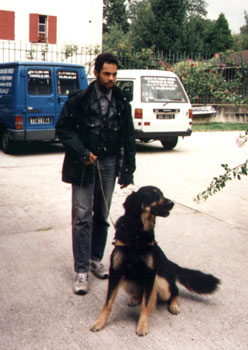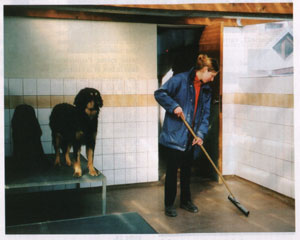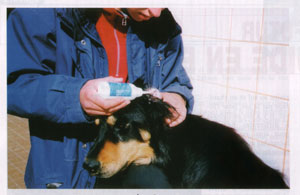 |
 |
||||||||||||
|
|||||||||||||
|
|
Training a future guide dog A trainer is put in charge of the puppy when he is returned to the school at 1 year of age.
Every trainer takes care of 3 dogs and they are his responsibility until they die. A trainer is put in charge of the puppy when he is returned to the school at 1 year of age.
Every trainer takes care of 3 dogs and they are his responsibility until they die.The training programme takes 6 months and has 3 aims: - Obedience - Search - Obstacles The Paris school has created its own programme based on the natural method. The goal is produce a guide dog that is infallible and easy to handle for a person who is visually impaired.
The guide dog shares man's life and must therefore find his place in that hierarchy. He will have several masters: the host family, his trainer and then the visually impaired person. In each case man must achieve the primary position in the hierarchy. This is done by molding the dog psychologically, creating a strong bond between master and dog, so that the latter accepts to be dominated. Everything the puppy has been taught thus far is repeated and positively reinforced. This is done through continuous obedience training but also in playing games with him. He is constantly reminded of his position in the hierarchy, but other traits are also reinforced, some of which are vital for the future. Each dog learns differently and the trainer needs to keep this in mind. The partnership, which is built on bonding and hierarchism, can only succeed if both partners are solid and trust each other. Durant The exercises done when the dog was a puppy will have laid the ground work for this. His inherent defensive trait will be ignored and not reinforced. The education of a guide dog is based on 3 fundamental ideas: The natural disposition of the dog, his need for physical contact and apprenticeship rules. The Natural Disposition of the Dog
Apprenticeship Rules: these come from the on the job training and include classical and instrumental conditioning, his receptiveness. They are also based on observations made during training and on the progress of the dog. What is needed most is patience!
 A guide dog is not trained in a day and the host family essentially puts the dog on the right track. Progress is assured by regular exercises and he gets used to a life in which he is given commands and is expected to execute them.
This training includes basic hygiene (defaecating off the curb), obedience (walking on the leash, sit, down, stand and come commands).
A guide dog is not trained in a day and the host family essentially puts the dog on the right track. Progress is assured by regular exercises and he gets used to a life in which he is given commands and is expected to execute them.
This training includes basic hygiene (defaecating off the curb), obedience (walking on the leash, sit, down, stand and come commands).
These exercises are essential in controlling the dog and getting him to behave correctly in public. For a proper socialization the host family takes the puppy everywhere, so that he may experience as many things as possible. This is done gradually. He should never experience fear as this would be detrimental to his emotional stability.
The actual training of a guide dog begins at 1 year when he leaves his host family and becomes the charge of a trainer at the school. To begin with the trainer has to establish a relationship with the dog and make him feel at home in his new surroundings. The log book is used for guidance and their first encounter usually takes place in an open area like a forest. The trainer has to win the dog's trust outright, so he needs to send clear signals from the start. By being unequivocal, precise and repetitive at the outset the trainer will help the dog slip into the submissive, yet self-assured role required of him. During this first encounter the trainer will watch the dog closely in order to establish to what degree he will cooperate naturally. The dog will be leashed which allows the trainer to see how he walks on a leash. He can also assess his emotional stability and note what attracts and what startles him. The ApprenticeshipThis consists of sessions of obedience training followed by games. The dog has fun, all the while learning and accepting who is the boss - his trainer.The obedience training consists of:
Once the dog is at ease on a basic trail, different obstacles are placed in his way, initially on the ground, then half way up and thereafter high up. This will teach him 2 skills:
ReinforcementThis starts when the trainer lets the dog begin to use his own initiative. It involves making mistakes voluntarily, to see whether the dog will correct them or not, e.g. when the dog indicates a raised obstacle the trainer will ignore him and head straight for it. The dog, while lying down, will refuse to advance which is what he was taught. He will be praised profusely and rewarded for having opposed his master.The Final PhaseThe trainer is blind folded and, accompanied by a colleague, will analyse in live situations the strengths and weaknesses of the dog. This takes place prior to certification.The TestAt the end of the training period the dog is tested and given a diploma which certifies his ability to guide a blind or visually impaired person. During the test the dog has to follow an unknown route with his blind-folded trainer. The route will contain all the difficulties he has come across during his training. This test is compulsory for all dogs at the Paris school prior to being given to a blind person.Some of the exercises:
Limitations of a Guide Dog :« The dog cannot do everything. Or rather, we have not been able to teach him everything. Like us he is fallible, but his mistakes are never intentional.»J. Romero One of the main difficulties is raised obstacles. Another is the watchfulness of the dog when crossing. He is not totally reliable. So it is important that a trainer also work with the visually impaired person before he/she gets a dog. They will be taught to command the dog and only then will he cross.
FROM THE MOUTH OF A FUTURE GUIDE DOG IN TRAINING
By J. Romero The trainers at the Paris school believe I have to feel great all day so that I can learn what they teach me. So I'll tell you what I do during my 6 weeks at the school. Each trainer teaches 3 dogs at one time. They take great care when they choose us. This is very important because if we start off on the right foot we'll be soul mates forever. As far as I'm concerned, all I want to do is eat, drink, play, be cuddled and please my trainer when we're working. Life at the school is very different from the one I lead with my host family but it's ok. Our living quarters consist of 3 areas: a box, a small courtyard and an enclosure where we relax. The box is closed at night. It is spacious, with tiled walls and a resin floor covering. In winter the floor is heated. Duckboards are placed at different heights to respect our hierarchy. There is always fresh water available.  The courtyard is fenced with wire-netting. Only very rarely does one of us jump over it. It also has duckboards.
The courtyard is fenced with wire-netting. Only very rarely does one of us jump over it. It also has duckboards.
I share the enclosure with the other dogs of the kennel. We are never more than a dozen. This is where we relieve ourselves one last time at night, at about 9 pm. These 3 areas are kept meticulously clean. Once a week the box and the courtyard are vacuumed. The vans that transport us and the paths we use are disinfected regularly.  On weekdays the trainers arrive at 8 am. After lively "good mornings" we are immediately led to the gutters to relieve ourselves. The trainers then clean up after us. They are very attentive and we like that.
On weekdays the trainers arrive at 8 am. After lively "good mornings" we are immediately led to the gutters to relieve ourselves. The trainers then clean up after us. They are very attentive and we like that.
The first thing they then do is read the log book of the weekend events, if any. Then we do group exercises till 10 am, e.g. recall, retrieving, as games initially but then we do some serious work. Back at the school we drink and eat, are brushed and the trainers examine us carefully. Particular attention is given to our eyes and ears. Sometimes we are weighed and every 2 months we are de-wormed. Bonding is sometimes difficult. We make mistakes because it isn't easy trying to be a "human" dog. After 10 am on Mondays we relax because the trainers have a meeting. They join us again after lunch, with their notes labeled "Progress and Goals". They don't mean much to us, of course. And off we go. We have a choice of as many as 30 different places, e.g. a market, a subway. This is where we do our exercises, which are adapted to our level of training. The trainer takes the three of us to town often, in a car. I am the most obedient so he always fetches me last. When we are all together he always pats the strongest of our group first. Only when we are alone do I get a lot of attention. How time flies! Before you know it it's 4.30 pm and we're heading back to the school. Here he prepares our dinner. After that we go to the enclosure where we stay for about 15 minutes and get our last cuddles of the day. There's Colin! He's in charge of the kennel until 9 pm. He always chats with the trainers, what they call an "exchange of information'". Before he leaves he sweeps up and he checks on everything and everyone. Some evenings we go out with the trainer so that he can get to know us a little better. But sometimes it's because we are feeling a little sad. A real treat is when we stay with him the entire weekend - 2 full days, just the 2 us! Otherwise we spend the weekend at the school, go for long walks and get a marrow bone on Sundays. We follow the same routine every day. Apparently this is very important for us. So our days never change, but our trainers sometimes do. They are especially tense when they are blind-folded to mimic a blind person. That's on test days. |
||||||||||||
|
|
|||||||||||||